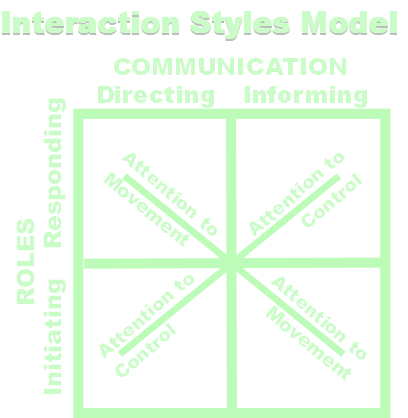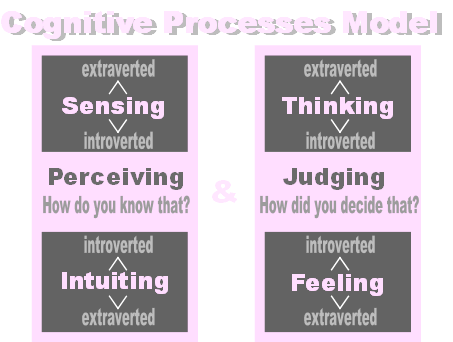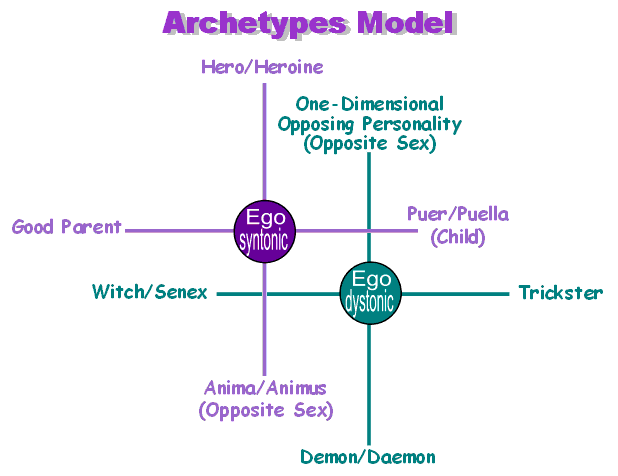|
This
page is for the know-it-alls. The ones who think they know about this type
stuff. The ones who have read all the materials they can find on the
internet, and are now making up their own theories about how these concepts
work.
If
that's not you, SKIP THIS PAGE. It won't help you. Go on to the next
page and enjoy yourself.
IF
YOU'RE ONE O' DEM WISEGUYS...
Mebbe
youse thinks youse knows alla these models by now and nobody can tell you nothin'.
Mebbe youse thinks you could sit around and chew de fat with Papa Jung, tellin'
him how to improve his feeble idears. Mebbe youse tink Isabel was a bored
housewife who hadda cute idea but she shoulda stuck to bakin' cookies and left
the psycho-metric junk to brainiacs like youse.
Izzat
right....?
If
dat's youse, cut youse teeth on dis:
When
you learn ballet (trust me here), they teach you five basic dance
positions. Only five. And those five positions, in various
combinations, comprise every possible ballet movement there is.
Really! Knowing those five basic principles will carry an entire dance
career.
The
crazy fact is that the world's most famous prima dona ballerina could take ballet class alongside my 3-year-old niece at the barre and get just as much out
of the class. Truly! Because you can never get the basics
perfect. Ballet dancers are continually striving toward the perfect
turnout, the perfect pointe, the perfect plie. It's always the same five
positions -- everybody just comes at it from their own level of expertise.
Now
back to personality type.
Do
you know the basics of the theories? If so, how well?
See,
I run into know-it-alls every day who think they know what they're talking
about, but when it actually comes to knowing the "five basic
positions" (or in this case, the basic models), I find most people woefully
ignorant. They don't know the basics! They never learned the
underlying principles. Or they know one or two dimensions, but not all of them.
So
if you're a wisenheimer and you think you know these models already, here's a
chance to test yourself.
Below,
I re-created the basic matrices for the four models I rely on. The hitch
is that I left some labels off the graphics.
Can
you fill them in with the appropriate type codes, labels, or functions?
Try
it, and see how well you do.
TEMPERAMENT
Let's
do Temperament first. Can you fill in the four quadrants with the proper
Temperament names and the corresponding letters of the type code? If so, have at it!

This
is the model I turn to when I want to understand WHY people do the things they
do -- what their core values and needs are. With this model, I can
establish two letters of the type code.
INTERACTION
STYLES
Same
exercise different model. Can you fill in the four quadrants with the name of
each interaction style, and the accompanying type code?

This
is the model I turn to when I want to understand HOW people do the things they
do -- to identify their "user interface." With this model, I can
clarify the remaining two letters of the type code.
(In
case you're not paying attention, please note that I have now identified the
full four-letter code.... and I haven't mentioned Type or whipped out a
Myers-Briggs test.)
COGNITIVE
PROCESSES
Most
people think they know this one, but they've usually reduced it to
stereotype. You might want to pay attention to how my model looks
different. The "quiz" is whether you can fill in each of the
gray boxes with the correct type codes -- tops and bottoms.

This
is the model I turn to when I want to understand how people THINK about things,
and what tools they rely on to get the job done. With this model, I gain
insights about how they like to spend their time, and what their personal
philosophies might be.
ARCHETYPES
MODEL
I
don't care how much you know -- I bet you don't know this model.
Here's the test: can you map all 16 personality types to it, besides your
own?

This
is the model I turn to when interpersonal dynamics are in conflict. When a
person dislikes another person on sight, or seems bent out of shape by some
situations, this model lets me know what dynamics might be in play.
HOW'D
YOU DO?
If
you're looking for the right answers... I don't give them. There's no
answer sheet! It's up to you to do the work to fill in the gaps in your
knowledge. To help you, I recommend the books on this
list.
You'll
learn more about these models on the following pages. Check out the menu
on the left.
Have
fun, wiseguy!
| ![]()
![]()